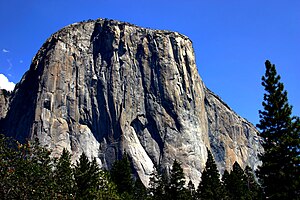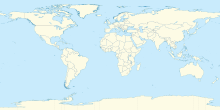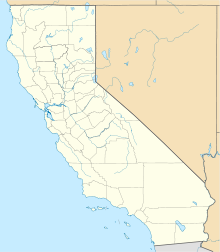Template:Infobox climbing route/doc
| This is a documentation subpage for Template:Infobox climbing route. It may contain usage information, categories and other content that is not part of the original template page. |
| This template uses Lua: |
This template can be used to create an infobox for articles about climbing routes.
Usage edit
This box includes the most often used parameters. Specify the coordinates for the start of the route.
| {{{name}}} | |
|---|---|
| {{{other_name}}} | |
| [[File:{{{photo}}}|{{{photo_width}}}|alt={{{photo_alt}}}]] {{{photo_caption}}} | |
| Location | {{{location}}} |
| Range | {{{range}}} |
| Coordinates | 0°N 0°E / 0°N 0°E{{{coords_ref}}} |
| Climbing Area | {{{climbing_area}}} |
| Route Type | {{{route_type}}} |
| Vertical Gain | {{{vertical_gain}}} |
| Pitches | {{{pitches}}} |
| Rating | {{{rating}}} |
| Grade | {{{grade}}} |
| Established by | {{{established_by}}} |
| First ascent | {{{first_ascent}}} |
| First free ascent | {{{first_free_ascent}}} |
| Fastest Ascent | {{{fastest_ascent}}} |
| {{{embedded}}} | |
{{Infobox climbing route
| name =
| photo =
| photo_width =
| photo_caption =
| map =
| map_width =
| map_caption =
| location =
| coords =
| coords_ref =
| climbing_area =
| route_type =
| vertical_gain =
| pitches =
| rating =
| grade =
| bolted_by =
| established_by =
| first_ascent =
| first_free_ascent =
| fastest_ascent =
}}
Parameter descriptions edit
This table describes all the parameters available. Many are seldom used and a functional infobox can be created using the parameters listed above.
| Parameter | Description |
|---|---|
name
|
Name of the route, the article is likely disambiguated but this name in the infobox should be the undisambiguated name. For example, The Nose for The Nose (El Capitan) or Action Directe for Action Directe (climb). This field is required. |
other_name
|
Other names by which the route is known. For example with La Rambla (climb), or famously Realization (climb) |
photo
|
Photograph of the mountain. Preferably a distance shot to show most/all of the mountain rather than a view from the summit. Do not include the "Image:" prefix. If uploading a new image, please put them on Commons for wider use. |
photo_width
|
Determines the width of the photograph. The default and maximum value is 300px. Images with a horizontal orientation (landscape mode) will generally display well at the default setting. An image with vertical orientation (portrait mode) will need to be adjusted. For example, photo_width=200 and not photo_width=200px.
|
photo_alt
|
Alt text for the map. See WP:ALT. |
photo_caption
|
Description of the photograph which is displayed below. Include the month and year if known. |
map |
The name of the location map to be displayed. See Map display methods. To use a static image, use |map_image=
|
map_image |
The file name of a static map image to be displayed. To use a location map, use |map=.
|
map_width
|
Determines the width of the map. The default width is 220px and maximum width is 300px. For example, map_width=180 and not map_width=180px.
|
map_alt
|
Alt text for the map. See WP:ALT. |
map_caption
|
The caption that will appear below the map if one is required. |
relief
|
Selects a relief map when assigned any value; functional when a location map template is used. See Map display methods. |
mark
|
A marker which shows the location of the route on a map. The default image is Red pog.svg. For more information, see Template:Location map. |
marker_width
|
The width of the location marker image in pixels. Seldom used. The default width is 8px. |
label_position
|
This seldom-used parameter will generate a text label next to the location marker. Valid values are left, right, top and bottom. If no value is assigned to the label parameter below, the name will be used.
|
label
|
Text that will be displayed next to the location marker. See label_position above.
|
location
|
Province or state first, followed by country. For the USA, the county is optional but if given, be provided before the state. |
coordscoordinates
|
For the {{Coord}} template. |
coords_ref
|
Strongly recommended. Specify a citation for the coordinates using <ref>...</ref> tags.
|
climbing_area
|
Name of the climbing area. Example: Indian Creek (climbing area), Ailladie or Fair Head |
route_type
|
This is the type of climbing route. Examples being: Big wall climbing (Salathé Wall), Traditional climbing (Prinzip Hoffnung), Sport climbing (Silence), Bouldering (Dreamtime), Ice climbing, Alpine climbing, Mixed climbing, or whatever makes sense. |
vertical_gain
|
Vertical height of the climb from start to finish. |
pitches
|
Typical number of pitches used to complete the climb. |
rating
|
Technical difficulty rating in the system for the area (e.g. French, America, UIAA, etc.). See Grade (climbing). |
grade
|
Roman numeral Grade that indicates the length and seriousness of the route in American NCCS commitment grade rating system. E.g. Grade I (1-2 hour climb) to Grade VII (climb lasting a week or longer). |
bolted_by
|
The individual who bolted the route, which may not be the first to climb it. Parameter used only for sport climbs. |
established_by
|
The individual who defined the route; is typically also the first to climb it, but can be significant when it is not. Parameter used for traditional, mountaineering and ice climbing. Use bolted_by for sport climbs, and route_setter for artificial routes.
|
route_setter
|
The individual who designed the route (used only for artificial climbing wall routes, such as the here). |
first_ascent
|
The climber who first ascended the route, then the year of the ascent. |
first_free_ascentffa
|
The climber who first redpointed the first free ascent of the route, then the year of the ascent. This is often the same as the first ascent but can be significant when it is not. For example, on The Nose (El Capitan) or Cobra Crack. |
fastest_ascent
|
Significant for a few climbs, and mainly on El Capitan, unimportant for most climbs. |
Example edit
The Nose edit
| The Nose | |
|---|---|
 Southwest face of El Capitan from Yosemite Valley | |
| Location | California, USA |
| Coordinates | 37°44′02.4″N 119°38′13.2″W / 37.734000°N 119.637000°W |
| Climbing Area | Yosemite Valley |
| Route Type | Aid climbing |
| Vertical Gain | 2,900 feet (900 m) |
| Pitches | 31 |
| Rating | 5.13+ or 5.8 C2 |
| Grade | VI |
| First ascent | Warren Harding Wayne Merry and George Whitmore, 1958 (45 days). |
| First free ascent | Lynn Hill 1993 |
| Fastest Ascent | 2:37:05 Hans Florine and Yuji Hirayama, 2008. |
{{Infobox climbing route
| name = The Nose
| photo = Yosemite El Capitan.jpg
| photo_caption = Southwest face of El Capitan from [[Yosemite Valley]]
| location = [[California]], [[United States|USA]]
| other_name =
| coords = {{coord|37|44|02.4|N|119|38|13.2|W|type:mountain_region:US}}
| climbing_area = [[Yosemite Valley]]
| route_type = [[Aid climbing]]
| vertical_gain = {{convet|2900|ft}}
| pitches = 31
| rating = 5.13+ or 5.8 C2
| grade = VI
| established_by =
| first_ascent = [[Warren Harding]] [[Wayne Merry]] and [[George Whitmore (climber)|George Whitmore]], 1958 (45 days).
| first_free_ascent = [[Lynn Hill]] 1993
| fastest_ascent = 2:37:05 [[Hans Florine]] and [[Yuji Hirayama]], 2008.
}}
Open Book edit
| Open Book | |
|---|---|
 The first two pitches follow the obvious corner. | |
| Location | Tahquitz Peak, California, United States |
| Coordinates | 33°45′38″N 116°41′06″W / 33.7605°N 116.685°W |
| Climbing Area | Tahquitz |
| Route Type | Trad |
| Vertical Gain | 300 feet |
| Pitches | 3 |
| Rating | 5.9 |
| First ascent | John Mendenhall & Harry Sutherland, 1947. |
| First free ascent | Royal Robbins & Don Wilson, 1952. |
{{Infobox climbing route
| name = Open Book
| photo = Open Book Tahquitz.JPG
| photo_caption = The first two pitches follow the obvious corner.
| photo_width = 220
| map = California
| map_width = 220
| map_caption = Map showing the approximate location of Open Book
| location = [[Tahquitz Peak]], [[California]], [[United States]]
| coords = {{coord|33.7605|N|116.685|W|type:mountain_region:US}}
| climbing_area = [[Tahquitz Rock|Tahquitz]]
| route_type = [[Traditional climbing|Trad]]
| vertical_gain = 300 feet
| pitches = 3
| rating = 5.9
| grade =
| established_by =
| first_ascent = [[John Mendenhall (climber)|John Mendenhall]] & [[Harry Sutherland]], 1947.
| ffa = [[Royal Robbins]] & [[Don Wilson (climber)|Don Wilson]], 1952.
| fastest_ascent =
}}
Map display methods edit
Any image file can be displayed as a map: pass the file name (without File: or Image: prefix) to |map=.
A marker can be superimposed on a map using one of a set of special map templates. To display a marker, the geographic coordinates must be specified using the {{Coord}} template inside the |coordinates= parameter. See the documentation for {{Location map}}. The parameters for this template map to a subset of the parameters used by {{Location map}}. A map template can be found using these sources:
- List of templates – Many of the listed items are redirects and a few templates may not function as expected.
- Category:Location map templates - templates sorted by category.
- Special:WhatLinksHere/Template:Location map/Info – a search that might help.
- Special:PrefixIndex/Module:Location map/data/ – another search that might help.
- Special:Prefixindex/Template:Location map – another search that might help.
All of the names begin with the words "Location map" followed by the area covered. The value you need to specify is the area name. The map template for Canada is Location map/data/Canada. In this case specify |map=Canada.
| Four Corners, Canada | |
|---|---|
| Coordinates | 60°N 102°W / 60°N 102°W |
{{Infobox climbing route
| name = Four Corners, Canada
| map = Canada
| map_caption = Example using geographic coordinates
| coordinates = {{coord|60|N|102|W|display=inline <!-- for documentation page only - not general practice --> }}
}}
By default, {{Coord}} displays in the infobox only in the page title. Parameter |display=inline,title can be added to make the coordinates display at the top of the page as well.
Tracking category edit
See also edit


